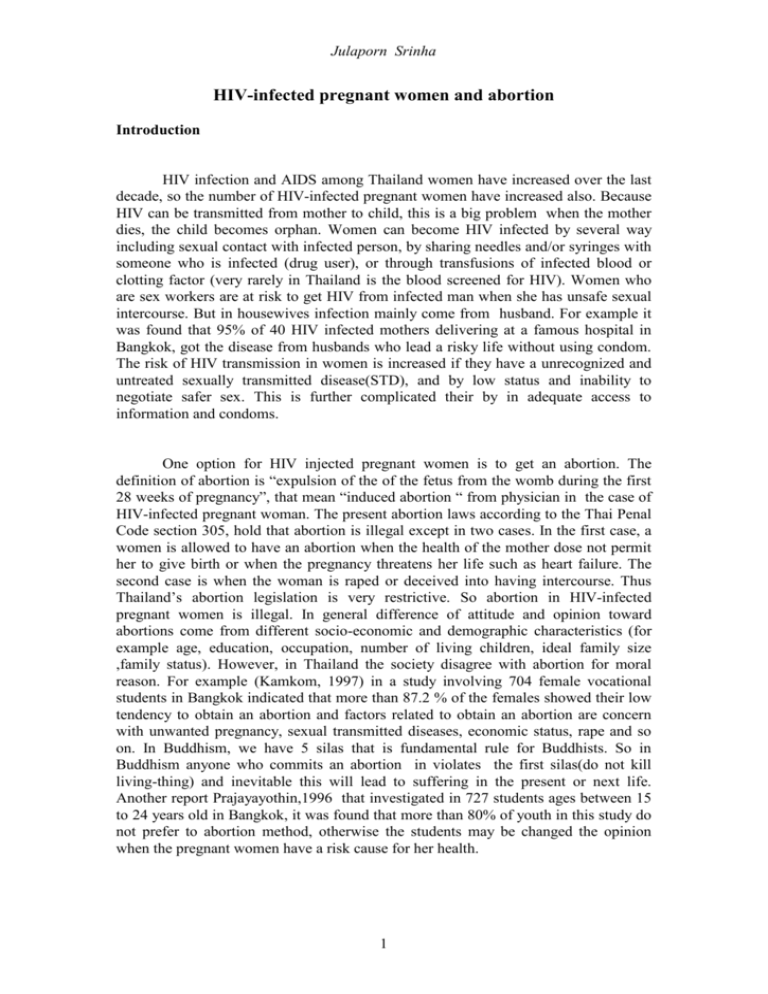HIV-infected pregnant women and abortion
advertisement

Julaporn Srinha HIV-infected pregnant women and abortion Introduction HIV infection and AIDS among Thailand women have increased over the last decade, so the number of HIV-infected pregnant women have increased also. Because HIV can be transmitted from mother to child, this is a big problem when the mother dies, the child becomes orphan. Women can become HIV infected by several way including sexual contact with infected person, by sharing needles and/or syringes with someone who is infected (drug user), or through transfusions of infected blood or clotting factor (very rarely in Thailand is the blood screened for HIV). Women who are sex workers are at risk to get HIV from infected man when she has unsafe sexual intercourse. But in housewives infection mainly come from husband. For example it was found that 95% of 40 HIV infected mothers delivering at a famous hospital in Bangkok, got the disease from husbands who lead a risky life without using condom. The risk of HIV transmission in women is increased if they have a unrecognized and untreated sexually transmitted disease(STD), and by low status and inability to negotiate safer sex. This is further complicated their by in adequate access to information and condoms. One option for HIV injected pregnant women is to get an abortion. The definition of abortion is “expulsion of the of the fetus from the womb during the first 28 weeks of pregnancy”, that mean “induced abortion “ from physician in the case of HIV-infected pregnant woman. The present abortion laws according to the Thai Penal Code section 305, hold that abortion is illegal except in two cases. In the first case, a women is allowed to have an abortion when the health of the mother dose not permit her to give birth or when the pregnancy threatens her life such as heart failure. The second case is when the woman is raped or deceived into having intercourse. Thus Thailand’s abortion legislation is very restrictive. So abortion in HIV-infected pregnant women is illegal. In general difference of attitude and opinion toward abortions come from different socio-economic and demographic characteristics (for example age, education, occupation, number of living children, ideal family size ,family status). However, in Thailand the society disagree with abortion for moral reason. For example (Kamkom, 1997) in a study involving 704 female vocational students in Bangkok indicated that more than 87.2 % of the females showed their low tendency to obtain an abortion and factors related to obtain an abortion are concern with unwanted pregnancy, sexual transmitted diseases, economic status, rape and so on. In Buddhism, we have 5 silas that is fundamental rule for Buddhists. So in Buddhism anyone who commits an abortion in violates the first silas(do not kill living-thing) and inevitable this will lead to suffering in the present or next life. Another report Prajayayothin,1996 that investigated in 727 students ages between 15 to 24 years old in Bangkok, it was found that more than 80% of youth in this study do not prefer to abortion method, otherwise the students may be changed the opinion when the pregnant women have a risk cause for her health. 1 Julaporn Srinha Mother to child transmission Up until now the number of infants who acquire the virus is rising rapidly in Thailand. The risk of a baby acquiring the virus from an infected mother ranges from 15% to 25% in industrialized (developed) countries and 25% to 35% in developing countries. On an average, one-third of children born to HIV-infected mothers will become infected themselves. Lower rates in developed countries may be because of a number factors, including the availability antiretroviral treatment of HIV-positive pregnant women. Higher rates in developing countries may be because of poorly nutritional and immune status. Therefor higher rates of sexually transmitted diseases among women in these countries. It is also not clear why some babies of HIV-positive women are infected while others are not. In general the transmission can occur in antenatal(during pregnancy), perinatal (delivery) or/and postnatal (breastfeeding) periods. During pregnancy period nobody know “Whether HIV infected will occur or not?” In addition HIV can find in amniotic fluid and placenta . Viscarello et al ,1992 studied serum and amniotic fluid obtained 13 seropositive (HIV positive) women before elective termination of pregnancy by using Enzyme-linked immunosorbent assay(ELISA), western blot antibody, p24 antigen assays. The p24 antigen was found in the maternal serum and amniotic fluid from 5 of 13 women(38%) and in serum from only 3 of 13 (23%). Since HIV was found in vaginal fluid, during delivery as a baby is exposed to maternal blood and secretions while passing through the birth canal. It appears that the time this period to contact in vaginal canal and cervix may be very important for HIV transmission. Because of HIV can be found, milk breastfeeding can also promote in HIV transmission. The baby can become infected at any point from early pregnancy until the end of breastfeeding. It is though that about a third of mother-to child transmission occurs during pregnancy, and about two-thirds around the time of delivery and afterwards. Figures for the proportion of babies infected during breastfeeding vary, but on an average it is though that breastfeeding is responsible for 14% of mother-to-child transmission. However the risk of HIV transmission from mother to child appears to be high for a recently infected mother who has high virus in the blood and other body fluid. Analysis of a number of studies of breastfeeding and HIV found that the transmission rate was around 14% from mother who were already HIV positive at the delivery but the rate of transmission from mothers who were infected after delivery and during the breastfeeding period was 29%. In addition a woman who has more advanced HIV disease also has a higher viral load and the risk of HIV transmission to the baby during pregnancy, birth or breastfeeding to be higher. The low birth weight and premature babies have higher rate of infection may be because their immune systems are not fully developed and they are less able to fight off HIV. Sometime if the mother has severe vitamin A deficiency, it appears that the transmission is greater than normal. Thereby suggestion that nutritional deficiency also play a role in HIV infection. Preventing mother-to-child transmission of HIV The most effective intervention to reduce mother-to-child transmission is preventing infection in women before and during pregnancy, in perinatal period and while they are breastfeeding. This is very important, not only for the health of the 2 Julaporn Srinha mother but also for the baby. Most women find out that they have HIV during pregnancy. Antiretroviral therapy have been used to reduce the transmission from mother to child. In the study of Mauskopf, 1996 (ACTG Protocol 076 in Thailand) the HIV transmission rate in AZT-treated (zidovudine) pregnant women reduced significantly (25.5% to 8.3%). Beside, treatment costs for HIV-positive pregnant women and their newborns also reduced depending on the reduction of transmission rate. Research at Beth Israel Deaconess Medical Center in Boston has found that 24 pregnant women whom received zidovudine during last trimester, 7 of 24 (29%) women transmitted HIV to their babies. Some trail, in 414 women when received zidovudine during pregnancy, 10.6% gave birth to have infected babies during vaginal delivery and 1.7% during cesarean, so cesarean may help reduce HIV transmission. HIV-positive women are advised not to breastfeed as it appear that babies are at risk when braestfeed by HIV-positive mothers. Putting this recommendation into practice is not easy because breastfeeding protects babies against other infections. In addition, formula and animal milk are expensive. It appear that breastfeeding is the only option for HIV infected women in areas where infectious disease and malnutrtion are the main cause of infant deaths and where infant mortality is high. This is because a baby’s risk of HIV infection from breast milk is likely to be lower than its risk of death from infectious diseases. In Thailand HIV-positive women are recommended to use formula or animal milk. Decision to continue or terminate pregnancy in HIV-infected pregnant woman The numbers of people who decide to have an abortion or continue pregnancy appear to vary. Example Selwyn et al,1989 studied among intravenous drug users and found that 14 of 28 (50%) HIV-positive chose to terminate their pregnancies. Sunderland et al,1992 studied and found that 6 of 32 (18.8%) seropositive women chose abortion. The first research Chaiprasitti, 1994 from Thailand on in-depth interviews of 9 HIV-infected women. It was found that 4 women (44.4%) decided abortion while, 5 women (55.6%) decided to continue their pregnancies. The process of decision making was complicated. Not only medical factors, but also social factors highly influenced the decision-making process. These factor were perception and understanding of medical information from their counselor, perceived severity of AIDS and expectation of the magnitude of problems that would occur to them and their families, the economic status of their families and the ability of afford future expenses and their status or power within their families. The second report from Kongsakron, 1995 in 20 HIV-positive, in one of hospital. While four of them (20%) decided to terminate pregnancy but eighteen (80%) mother who continued their pregnancy set priority to other factors such as strong desire for children, take a chance of risk in virus, transmission rely on their healthy, status. Besides this, it was found that factor and to against terminating pregnancy included husband’s choice, gestation age and limitation of medical service. A survey research from Auttagovit, 1995 consist of 154 case of HIV-infected pregnant women in Petchaburi province. About 38 case (24.7%) decided to terminate pregnancy and while 116 (75.3%) continued pregnancy. A descriptive study by Teanchai, 1996 involved 150 HIV infected pregnant women in the 7 government hospitals, of 6 provinces in the upper northern part of Thailand. About 38% of the HIV infected pregnant women infected to have an 3 Julaporn Srinha abortion. There were nine factor; perception of severity of HIV infection in mother infant, education, religion, husband’s perception of his wife in HIV infection, perception of abortion age at marriage, domicile, economic status of the relatives, and tangible support from the husband significantly discriminate the HIV infected pregnant women’s intention. Among three factor; the perception of HIV infection in the mother/infant ,domicile, economic status of the relatives were very powerful factors. Above of all that show many different factors play a role in the decision vary. Children with HIV often have the same illness as children without HIV, but these may be more serious, frequent or difficult to treat. About 4 in 10 infected children die by the age of 12 months, many survive beyond two years of age, and some have reached adolescence. In addition to children who are living with HIVinfected parents who are either sick or dying there are many children who have been orphaned by AIDS. They may have lost a mother or a father or both. In Thailand, over 200,000 children-a third of them under five-are expected to lose their mothers because of AIDS by 2005. Loss of a patent or parents can affect young children in many way. The effect vary from country to country and depend on culture social and family structures, and grandparents or older sibling who are unable to cope or to afford extra food and clothing. Children from families affected by HIV and AIDS may be stigmatized and rejected and not allowed to play with other children. In addition the health of children under fives who do not have a mother is generally worse than that of those who do. The mother have relied on to bring a child for immunization ,to seek treatment for children illness and to ensure that a child is well nourished. Not on the healthy but also economic problem in HIV families, because treatment costs are too expensive for them to pay. Although physician treat HIV patients, in a recent survey it was found that most were unwilling to take care of AIDS/HIV positive patients most expressed fear in risk when working with AIDS/HIV positive patient (YEE, 1991). String et al,1999, studied 480 Thai physicians it was found that many physicians were unwilling to perform pelvic examinations (19.2%) ,vaginal deliveries (30.7%) or cesarean deliveries (39.5%) on women who were know to be infected with HIV. Above all it found that when the women decided to continue pregnancy, she faced with several problem such as to depression and the future of herself, her husband and her baby, her economic situation, discrimination from relatives and families. Women, who decided to have an abortion, the issues include side effect or danger from abortion especially in illegal hospital or clinic. Women ask the question “Is it deadly sin? Or Was I a sinner? Because in Buddhism a major rule for life is: do not kill living thing ; it a sin. So both of HIV-infected pregnant women have a problem and received the effect from these problem sometime the same sometime different. The appropriate way for these problem in Thailand First of all preventing infection in women is better in many ways than treatment so options are everyone in their society have responded for prevention for avoid risk of HIV infection. So educating people about HIV/AIDS prevention is very necessary. Advocacy for women in HIV screening test are very important to families to planing in the future. However when the women have HIV infection and pregnancy also. Physician would like to give correct data for pregnant women and her husband, 4 Julaporn Srinha her families or relatives, neighbor and people involved in support group to support both body health and spirit health. If she decided to keep her baby the government must have a system for them so that antiretroviral therapy (if it can prove clearly in cost effective and toxicity), power milk for child are available, In Thailand, if a mother cannot pay for powder milk the government service for 1 year age . In addition long term service is necessary since they are HIV-positive. Counselor service is very important to support the women. After parents died, the orphans would like to receive the service from families and government like another orphans. In Thailand HIV/AIDS is a national level problem and we received the help from several organization in the world. The budget paying in this problem is very high, about 1400,000,000 bahts in 1999 and about 1,000,000,000 bahts (72%) use in servicing ,treatment and counseling of HIV/AIDS patients. Above all when we return to the question “ A pregnant women’s right to choose to abortion when she have HIV infection ? This question is too difficult to answer. In some situation, you cannot decide they to be right or wrong, black or white. Similarly, you can not conclude if a pregnant women deciding to have abortion is wrong or right. Conclusion The HIV-infected pregnant women decide to continue or terminate pregnancy is the complex process, however more than 50% of women would like to continue pregnancy. Many factor play a role such as the data about disease from physician, belief, religion, her husband, her relatives or families, economic and social. when women conclude the factor after that she decided it . Mainly, women who decided to keep the baby, face longer and more serious problems than the one who terminate their pregnancies. Everybody would like to agree with a women’s decision and support her health both body and spirit health. In this situation you can not conclude pregnant woman decides to abort is wrong or right. It is her decision. We would like to support them as against judge them. References 1. Auttagovit P, 1995. Decision to Continue or Terminate Pregnancy in HIVinfected Pregnant Women. MD Thesis. Faculty of Science (Human Reproduction and Population Planing), Mahidol University.(Thai) 2. Chaiprasitti S, 1994. Decision-Making Process in Maintaining Pregnancy of HIV-infected Women. MD Thesis. Faculty of Arts (Medical and Health Social Sciences), Mahidol University.(Thai) 5 Julaporn Srinha 3. Cheasawan N, 1996. Life and Knowledge about AIDS in the HIV infected Mothers. MD Thesis. Faculty of Arts (Cultural Studies),Mahidol University.(Thai) 4. Kamkorn P, 1997. Cognitive factors related to the Tendency to Obtain an Abortion among Female Vocational Students in Bangkok. MD Thesis. Faculty of Arts (Medical and Health Social Science ),Mahidol University.(Thai) 5. Kongsakorn K, 1995. The process of Decision to Continue Pregnancy in HIV Infected Pregnant Women. MD Thesis. Faculty of Nursing (Maternity and Newborn Nursing).(Thai) 6. Mauskopf JA et al 1996. Economic Impact of Treatment of HIV-positive Pregnant Women and Their Newborns with Zidovudine: Implication for HIV screening. JAMA. 276 (2).p 132-138. 7. Prajayayothin P and Dhamprapa R, 1996.Unwanted Pregnancy: It’s Existing Solution from the Perspective of young adults in Bangkok and Abortion Law. Medicine and Law. 15(2).p 356-373. 8. Selwyn PA et al 1989.Knowledge of HIV Antibody Status and decision to Continue or Terminate Pregnancy among Intravenous Drug Users. JAMA. 261(24).p 3567-3571. 9. String JS et al, 1999. Prevention of Mother-to-child Transmission of HIV in Thailand : Physicians’ Attitudes on Zidovudine Use, Pregnancy Termination, and willing to Provide Care. Journal of Acquired Immune Deficiency Syndrome. 21(3).p 217-222. 10. Suderland A et al 1992. The Impact of Human Immunodeficiency Virus Serostatus on Reproductive Decision of Women. Obstetrics and Gynecology. 79(6).p 1027-1031. 11. Teanchai S, 1996. Factors Affecting Firstly Known HIV infected Pregnant Women’s Intention to have an Abortion in 6 Provinces in Upper Northern Part of Thailand. Ph.D. Thesis. Faculty of Education (Population Education), Mahidol University.(Thai) 12. Viscarello RR et al 1992. Fetal Blood Sampling in Human Immunodeficiency Virus Seropositive Women before Elective Midtrimester Termination of Pregnancy. BMJ. 305(6861).p 1053-1057. 13. Yee HH 1991. Attitude of Thai Doctors to that AIDS and HIV Positive Patients in a Government Hospital Bangkok. MD Thesis. Faculty of Public Health, Mahidol University. 14. http:// hivdent.org/pediatrics/pedhvivtip 052000.htm. 15. http:// hivdent.org/pediatrics/pedsaat 022000.htm. 6




